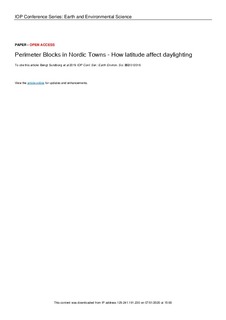| dc.contributor.author | Sundborg, Bengt Åke | |
| dc.contributor.author | Matusiak, Barbara Szybinska | |
| dc.contributor.author | Arbab, Shabnam | |
| dc.date.accessioned | 2020-01-07T15:01:13Z | |
| dc.date.available | 2020-01-07T15:01:13Z | |
| dc.date.created | 2019-12-06T20:47:18Z | |
| dc.date.issued | 2019 | |
| dc.identifier.issn | 1755-1307 | |
| dc.identifier.uri | http://hdl.handle.net/11250/2635166 | |
| dc.description.abstract | One of the design principles for future sustainable towns is compactness. The densification of cities is very much needed, but it usually compromises the access of daylight. Densification is especially challenging in the Nordic region characterized by low angled sunlight, something that also limits daylight distribution and restricts its intensity. The higher the latitude, the greater is the difficulty in the distribution. Perimeter blocks give shelter from wind and often create semi-public courtyards which have been seen to be attractive in many Nordic settlements during history. In the present study, alternative design to the conventional perimeter blocks are explored and geometric options such as chamfered corners, strategically varied building heights and differently positioned openings in a broken perimeter block are analyzed. The yearly simulations as well as simulations for May 1st have been carried out for the same perimeter blocks located at four different latitudes (decimal coordinates):
1. 65.0 Oulu (similar to Mo i Rana 66.3, Jokkmokk 66.6 and Rovaniemi 66.5)
2. 63.4 Trondheim (similar to Reykjavik 64.1, Östersund 63.2 and Vaasa 63.1)
3. 59.3 Stockholm (similar to Oslo 59.9, Helsinki 60,2, Tallinn 59.4, Saint Petersburg 59.9 and Anchorage 61.2)
4. 55.7 Copenhagen (similar to Malmö 55.6, Glasgow 55.9 and Moscow 55.8)
The choice of evaluation criteria is based on scientific discourse in the field of daylighting. According to the new European standard, solar radiation is included. Computer-based daylighting simulations are performed for different designs of the perimeter blocks with equal density, FAR = 1.33. The further north a city is located, the lower the houses in a perimeter block must be to maintain a certain level of daylight. The study confirms that latitude affects daylighting and that geometrical change can improve the conditions for daylight in the perimeter blocks. | nb_NO |
| dc.language.iso | eng | nb_NO |
| dc.publisher | IOP Publishing | nb_NO |
| dc.rights | Navngivelse 4.0 Internasjonal | * |
| dc.rights.uri | http://creativecommons.org/licenses/by/4.0/deed.no | * |
| dc.title | Perimeter Blocks in Nordic Towns - How latitude affect daylighting | nb_NO |
| dc.type | Journal article | nb_NO |
| dc.type | Peer reviewed | nb_NO |
| dc.description.version | publishedVersion | nb_NO |
| dc.source.volume | 352 | nb_NO |
| dc.source.journal | IOP Conference Series: Earth and Environmental Science (EES) | nb_NO |
| dc.source.issue | 1 | nb_NO |
| dc.identifier.doi | 10.1088/1755-1315/352/1/012016 | |
| dc.identifier.cristin | 1757788 | |
| dc.description.localcode | Content from this work may be used under the terms of theCreative Commons Attribution 3.0 licence. Any further distribution of this work must maintain attribution to the author(s) and the title of the work, journal citation and DOI. Published under licence by IOP Publishing Ltd | nb_NO |
| cristin.unitcode | 194,61,55,0 | |
| cristin.unitname | Institutt for arkitektur og teknologi | |
| cristin.ispublished | true | |
| cristin.fulltext | postprint | |
| cristin.qualitycode | 1 | |

